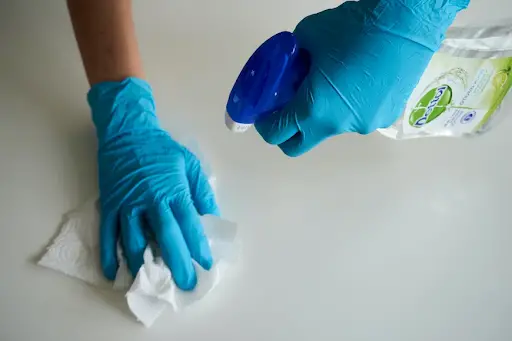
6 Ways You Can Keep A Hygienic Environment In The House
Maintaining a clean and hygienic environment within your home is not just about aesthetics - it's essential for your health and well-being. A hygienic living space not only prevents the spread of diseases but also promotes a sense of comfort and peace. From the kitchen where you prepare meals to the bathroom where you freshen up, every corner of your home deserves attention when it comes to cleanliness. So, here are six practical and effective ways to keep a hygienic environment in your house, ensuring that your living space remains a haven of health and happiness.
1. Regular Cleaning Routine
Creating a consistent cleaning routine is the cornerstone of maintaining a hygienic home. Set aside specific times each week to tackle different cleaning tasks. Dusting, vacuuming, mopping, and wiping down surfaces are all essential elements of this routine. This also includes having proper hygiene products at all times, including Schulke Asia sanitizers and wipes for easy cleanups. Pay special attention to high-traffic areas like the living room and kitchen, as well as often-neglected spaces like behind furniture and under appliances. Regular cleaning not only keeps allergens and germs at bay but also ensures that your home remains inviting and pleasant.
2. The Power of Proper Ventilation
Proper ventilation is often underestimated, but it plays a crucial role in maintaining indoor air quality. Open windows regularly to allow fresh air to circulate and stagnant odors to dissipate. Consider using exhaust fans in kitchens and bathrooms to prevent moisture buildup, which can lead to mold and mildew growth. Good ventilation not only helps in maintaining a hygienic atmosphere but also contributes to a more comfortable and pleasant living environment.
3. Declutter for Cleanliness
Clutter not only makes a space look messy but also provides hiding spots for dust, pests, and allergens. Regularly decluttering your home by getting rid of items you no longer need or use can greatly enhance the overall hygiene of your living space. Organize your belongings, and find proper storage solutions to keep things tidy and easy to clean. A clutter-free environment not only improves hygiene but also creates a sense of tranquility.
- Reduce Dust Accumulation: Cluttered surfaces collect dust more readily, making cleaning a constant battle. By decluttering, you eliminate potential dust traps, resulting in cleaner air and easier cleaning routines.
- Prevent Pest Infestations: Pests such as roaches thrive in cluttered environments where they can hide and find food sources. Decluttering denies them these hiding spots and minimizes their chances of invading your space.
- Improved Indoor Air Quality: Clutter can trap pollutants, affecting indoor air quality. Removing unnecessary items allows air to circulate freely, reducing allergens and improving respiratory health for everyone in your household.
- Enhance Mental Well-being: A clutter-free environment has psychological benefits. It promotes a sense of order and reduces visual chaos, leading to reduced stress and heightened mental clarity. A clean, organized space can significantly contribute to your overall well-being.
4. Kitchen and Bathroom Hygiene
The kitchen and bathroom are two areas that demand extra attention when it comes to hygiene. In the kitchen, clean countertops, sinks, and appliances after each use to prevent the growth of bacteria. Store food properly to avoid attracting pests. In the bathroom, regularly disinfect surfaces like sinks, faucets, and toilet handles to prevent the spread of germs. Replace shower curtains or liners if they show signs of mold or mildew. By prioritizing hygiene in these critical spaces, you ensure the health and safety of your household.
5. Mindful Material Maintenance
While we often focus on visible surfaces, don't overlook the cleanliness of your upholstery and flooring. Regularly vacuum and clean upholstered furniture to remove dust, dirt, and potential allergens. Depending on the material, consider using appropriate cleaning agents or hiring professionals for a deep clean. Similarly, different types of flooring, such as carpets, hardwood, and tiles, require specific maintenance techniques. Regularly sweep, mop, or vacuum these surfaces to prevent dirt buildup and maintain a fresh atmosphere throughout your home.
6. Laundry Hygiene for Clean and Fresh Fabrics
Maintaining a hygienic environment extends to the fabrics in your home as well. Pay attention to your laundry routine to ensure clean and fresh textiles. Wash bed linens, towels, and clothing regularly using the appropriate detergents, and consider using mesh laundry bags for delicate items like lingerie or smaller garments to prevent damage and tangling during the wash. Don't overload the washing machine to allow thorough cleaning. Remember to clean and disinfect your washing machine periodically as well. Sunlight can be a natural disinfectant, so whenever possible, dry your laundry in the sun. Proper laundry practices not only contribute to overall hygiene but also enhance the comfort of your living space.
Establishing a cleaning routine, maintaining proper ventilation, decluttering, focusing on kitchen and bathroom hygiene, mindful material maintenance, and laundry hygiene all combine to create a holistic approach to cleanliness. A hygienic home supports physical health, mental tranquility, and a sense of pride in your living space. By incorporating these practices into your lifestyle, you ensure that your house remains a safe, inviting, and refreshing haven for you and your family.